

1980s Funny Cars
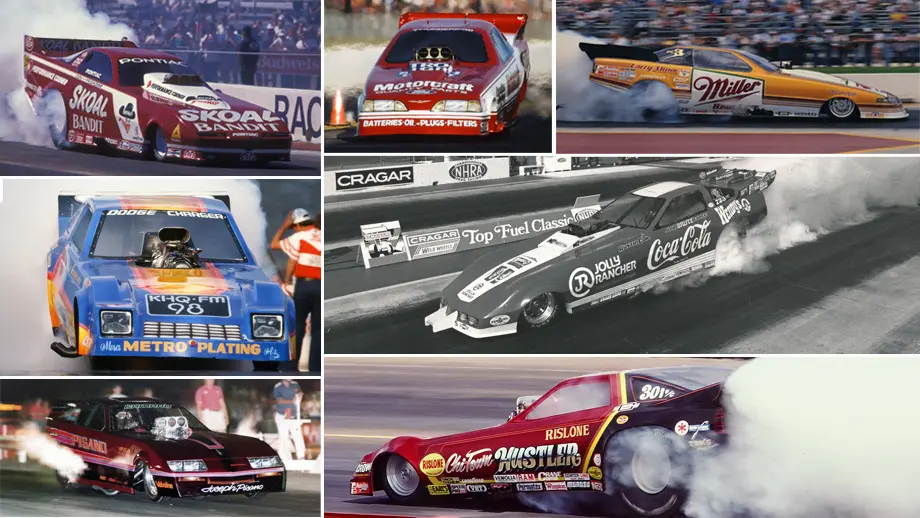
The 1980s seem so long ago -- much longer than the 30-plus years that have elapsed since then -- especially when it comes to Funny Car racing in the decade, which is the subject of today’s column and the final installment of photos from the Ron Lewis photo collection that already has spanned the 1960s, the 1970s (Top Fuel and Funny Car), and 1980s Top Fuelers.
How long ago was it? Consider, for example, that as of Dec. 31, 1989, John Force hadn’t even won the first of 16 Funny Car world championships and the ageless wonder is the only driver from that year’s Top 10 finishers who is still competing (more on that later). The 1980s was still a time when a guy with a self-funded car had a decent shot at winning a national event, though as the decade progressed, that likelihood diminished significantly as quickly as Kenny Bernstein and Dale Armstrong could invent new stuff.
As with the past columns on the West Coast-centric Lewis collection, this isn’t intended to be The Complete History of 1980s Funny Cars, but rather a group of images as memory stokers, useless trivia, and other stuff that I like to write about.

Speaking of John Force, here’s a cool burnout photo from the 1985 World Finals in Pomona, smoking the hides under the landmark starting-line banner. This was Force’s first season with Austin Coil on wrenches and they finished fifth in points, but it was hardly Force’s first Top 10 finish. He actually finished higher (fourth) in 1983 with Larry Frazier tuning and was eighth in 1979, but the best obviously was still to come. The Finals came on the heels of their first final together –- a runner-up behind John Collins two weeks earlier in Phoenix -- and the duo was still more than a year from Force’s first career win in Montreal in July 1987. They finished fourth in ’86 and ’87 and third in ’88, but, oddly, dropped to sixth in 1989, the year before they won their first championship.
Remember how I mentioned that Force was the only driver from the 1989 Top 10 still racing? (I mean, how could you forget? It was only 200 words ago.) Upon further research -– are you ready for this? -- he’s the only guy among the 35 drivers who finished in any 1980s Funny Car Top 10 who is still behind the butterfly, though fellow Top 10 finishers Jim Dunn, Jim Head, Mark Oswald, Johnny West, and Brad Tuttle are still in the game, though now on the tuning side of the engine. (By way of comparison, over the last 10 years, 2008-2018, just 20 drivers have been part of the Funny Car Top 10.)
Also worth noting in this photo is the nose-mounted extension that was allowed that year on certain bodies to give teams the same front-spindle-to-nose advantage (since it was widely understood that the nose of the car and not the front tires broke the finish-line beams).
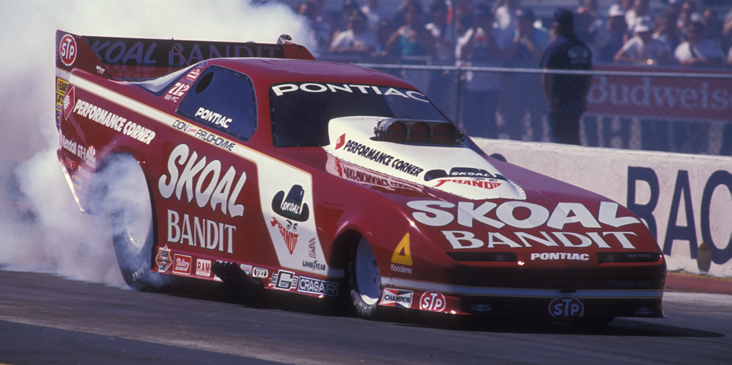
The end of the decade marked the end of Funny Car legend Don Prudhomme’s career in the class, but he went out with a bang in 1989, finishing second in points after wins in Sonoma and Dallas and, of course, his sweep of both the U.S. Nationals and the Big Bud Shootout in Indy. After his 1970s dominance, the ‘80s was a real mixed bag for “the Snake.” After 24 wins in the 1970s, he added just 12 in the 1980s, and none between 1982 Montreal and 1987 Gainesville, and even sat out the 1986 season due to (gasp!) lack of sponsorship. After the 1989 season, Prudhomme returned to his Top Fuel roots and added nine more wins to finish with a career total of 49 combined victories.

Where Prudhomme had owned Funny Car in the mid- to-late 1970s, the same was true for Kenny Bernstein in the 1980s, with the Budweiser King driver piling up 29 victories and four championships, but none of them more controversial than the 1987 crown won with the derisively nicknamed “Batmobile” Buick LeSabre, a legal-by-definition Funny Car body that created more waves than a Kajagoogoo concert. (Full disclosure: I don’t know if anyone actually did “the wave” at a Kajagoogoo concert; I just like saying Kajagoogoo.)
A few years ago, Bernstein recounted the tale behind the body: “Dale [Armstrong] told me what he wanted to do, and I told him, ’Well, the rules are pretty much open; you don’t have any reason not to,’ We had to build the plug and the mold before the first body ever gets kicked out, so it was a big, expensive proposition. I told him to tell me when we got to that point so I could take a look at it. So [when the first body was done], I go over there and look at it and say, ‘What in the world is that?’ I couldn’t even recognize it as a body. It was supposed to be a Buick, but I have no idea where that Buick came from. I said, ‘Oh my god; we’re in serious trouble; this is going to be tough. We’ve got to get NHRA down here; this is not going to be easy.’ Dallas Gardner, Carl Olson, Steve Gibbs, and three or four other guys came to see it, and you could hear a pin drop; they were astonished. ‘This is going to be a Funny Car body?’ They said to me, ‘We’re going to have some lunch and think about this.’ I said, ‘I’ve got $300,000 in this; go have a big lunch.’ They came back and told me I could run it for a year.” The team scored seven wins (including Indy, pictured) in 14 races en route to their third of four straight championships then returned in 1988 with a still radical-looking but toned-down Buick Reatta and won the championship again.
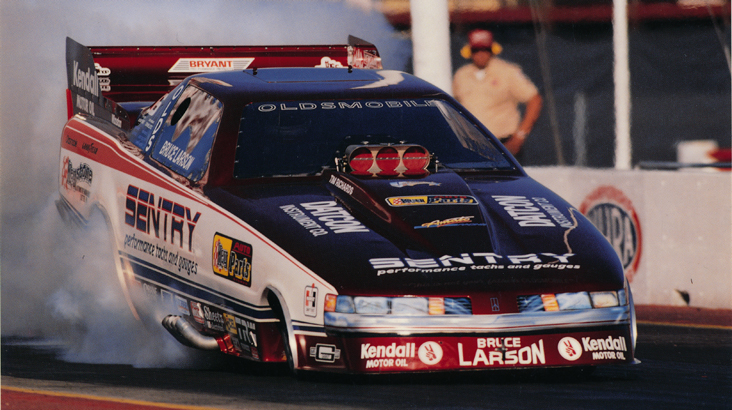
Bernstein’s string of championships, like Prudhomme’s in the 1970s, ended at four, but it was an unlikely source. Where Raymond Beadle dethroned Prudhomme for the ’79 crown in a trend you could see coming, no one expected Bruce Larson to win the 1989 championship. Larson, one of the class’ pioneers, had largely match-raced under ‘glass for the better part of three decades before he won his first NHRA national event title at the 1988 Cajun Nationals and had finished just sixth that year, but Larson and tuner Maynard Yingst, with an assist from the Joe Amato/Tim Richards braintrust, hit high gear in 1989 with season book-ending wins at both Pomona events as well as victories in Columbus, Denver, Seattle, and Phoenix to win the championship going away, finishing more than 3,000 points ahead of Prudhomme (300 points in modern-day scoring).
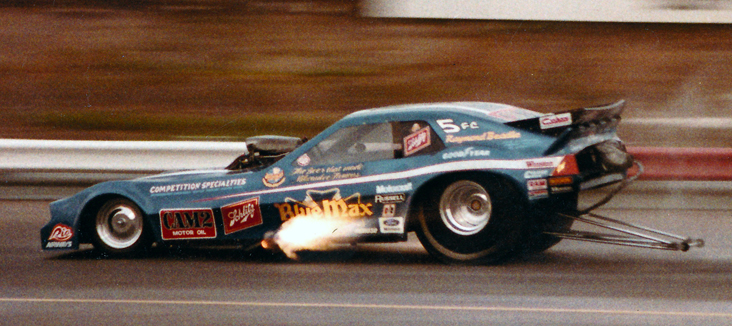
After winning the championship in 1979, Raymond Beadle and the Blue Max also won the title in the first two seasons of the new decade with his Mopar-bodied machines before switching to Ford in 1982 with this EXP, surely one of the not-prettiest Funny Car bodies in history. The Max won twice in 1982 (and also famously rolled at the Gatornationals) and slipped to fifth in points then eighth in 1983 before his final Top 10 showing, a fifth in 1984. His downfall seems to coincide with his growing interest (and expenditures) as a NASCAR team owner until the Max became a mere shell of itself, outside of new driver John Lombardo’s triumph at the 1985 U.S. Nationals.
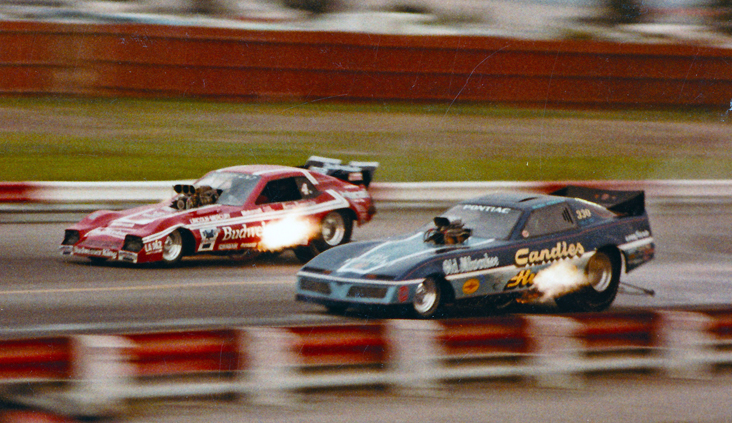
Bernstein ran a Mercury LN7 body –- sister car of the EXP –- and enjoyed great success in 1983, including his U.S. Nationals/Bud Shootout double, before he and Armstrong developed the wind-tunnel-influenced Ford Tempo that helped shape the Funny Car look for the next decade. The opponent in this qualifying matchup at the 1983 World Finals at Orange County Int’l Raceway is Mark Oswald, in his first season in the class after the Candies & Hughes team switched from Top Fuel to Funny Car.
As many accolades as J.R. Todd has received for his seamless transition from Top Fuel to Funny Car, the accomplishments of Oswald -– now tuner for three-time Top Fuel world champ Antron Brown -– seem (in my book) a bit overlooked in hindsight. Like Todd, Oswald won two races in his first year in Funny Car and also won the championship in his second year in the class. The difference is, where Todd finished ninth on his rookie year, Oswald finished second in the standings in his debut season behind our next subject …
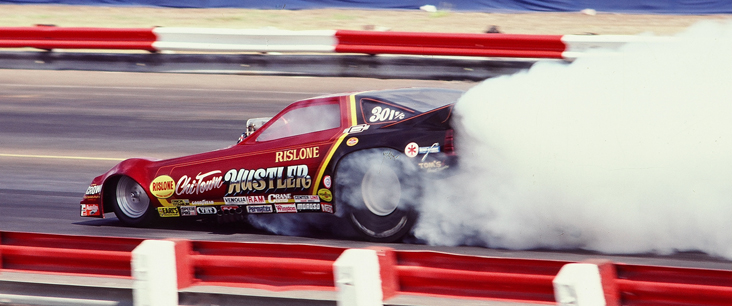
Years before he would tune John Force to his first championship, Austin Coil was the tuning genius and Frank Hawley the skilled wheelman that brought the Chi-Town Hustler back into the national spotlight in 1982. The Chi-Town car had, for years, been only an occasional national-event contender, but the team came out swinging in 1982, qualifying No. 1 with a 5.86 low e.t. and reaching the semifinals at the Winternationals, then winning the Gatornationals. They’d win again in Columbus and Brainerd en route to the championship, their first of two straight. Interesting to note in this photo from the 1982 Finals is the absence of Hawley’s name on the car, which jibes with the story he told me last year about Coil’s (I assume good-natured) reluctance to give him any job security. “Even after we’d won the world championship in 1982, he’d never truly hired me,” Hawley recalled. “It was like a week-to-week deal. After we won the championship, I finally asked him if I’d been hired, and he finally said yes.”
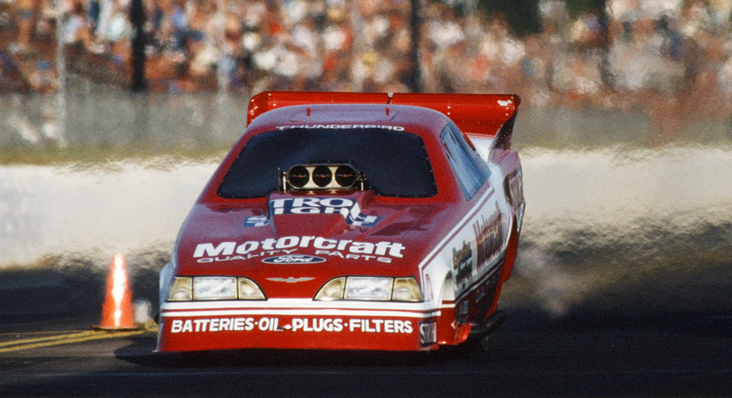
Hawley’s reign lasted two years (an interesting step down from four years for Prudhomme, three for Beadle, two for Hawley) before Oswald, Paul Candies, and Leonard Hughes made good on the promise they’d shown in 1983 by winning the championship in 1984. The team won the championship with a Trans Am-bodied machine but, after nabbing a Motorcraft deal in 1987, switched to Ford with this Thunderbird and finished second behind Bernstein and the aforementioned Batmobile. Oswald would finish second again in 1988 (again behind Bernstein) and fourth in 1989 and continued to finish in the top five until 1991, even though the C&H deal ended in 1990.
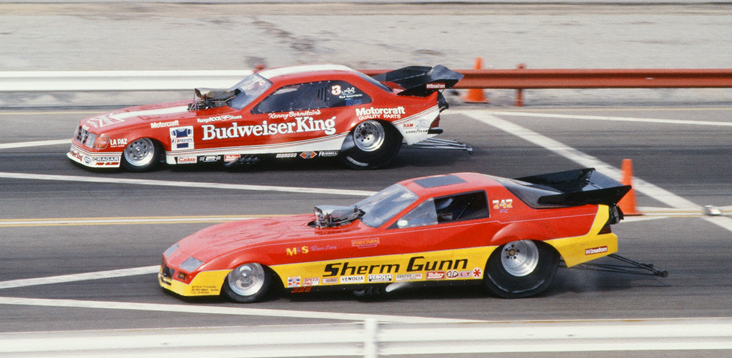
Oswald locked up his first championship at the Finals in 1984 (the first year it was contested in Pomona) but was upset in the final round by the guy in the near lane of his photo, local hero and chassis builder Sherm Gunn. Gunn’s improbable win –- the first and last of his career -- began with this holeshot-aided first-round victory over Kenny Bernstein, followed by a win against another former class champ, Don Prudhomme, then a pasting of Billy Meyer in the semifinals before beating head-gasket-blowing Oswald in the final.
Of great interest (to me, at least) in this photo is that although Bernstein lost the race by .005-second, he appears to be leading just a car length past the finish line in a typical “ran out of racetrack” loss, especially considering that he was running 10 mph faster (249 to 239) than Gunn. We know that the stripe behind the cars is indeed the finish line because back then the speed traps (denoted by the diagonal lines on the track) spanned 66 feet either side of the finish line and we can see them on both sides of the line in this photo. The speed traps were shortened to just 66 feet before the finish line -- to discourage drivers from running the car “out the back door” to get a higher speed mark, back when top speed points were still awarded -- at the start of the 1989 season.

And speaking of Billy Meyer, even though he never won a championship, people forget just how good he was for so long. He had three championship runner-ups (1980, ’82, and ’84) and three third-place finishes (’77, ’78 and as late as 1986) in nine Top 10 finishes that spanned 12 career wins, highlighted by an Indy victory in 1982. By the late 1980s, his business of racing had moved to track ownership after building Texas Motorplex in 1986. He also remains the youngest NHRA licensed Funny Car racer at 19 years three months when he officially debuted in NHRA competition in 1973. To read more about “Waco Willie,” check out this column I wrote a few years ago.

Fabled flopper pilot Ed “the Ace” McCulloch enjoyed a career renaissance in the late 1980s as part of Larry Minor’s Miller-backed team, scoring seven victories with the team after breaking a drought that extended from his 1980 U.S. Nationals win in the Super Shops Arrow until he won with Minor in Gainesville in 1986. Driving this Miller High Life Olds, “Ace” scored his fourth U.S. Nationals win in 1988 and ultimately finished a career-high second in points in 1990 (after winning Indy again), falling just two rounds shy of stopping Force from winning his first title. McCulloch would go on to add a sixth Indy title in Top Fuel in 1992 in Minor’s McDonald’s-sponsored dragster.
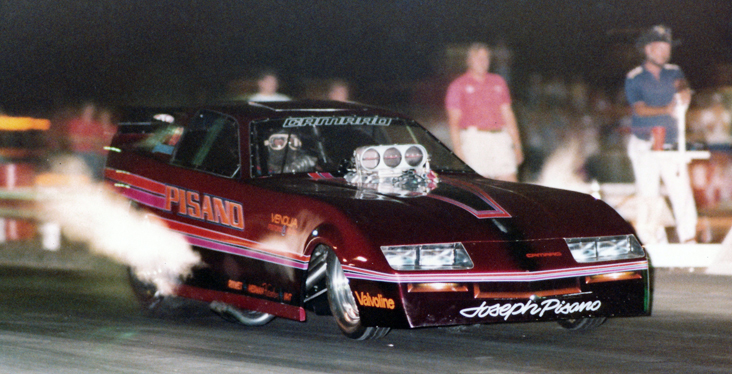
Legendary car owner and piston/engine-block manufacturer Joe Pisano gave Roland Leong a run for driver count (though his tenures were usually longer), employing a roster that included the likes of his brother Frankie, Sush Matsubara, Pat Foster, Jake Johnston, Tom Ridings, Craig Epperly, Al Segrini, Tripp Shumake, Mike Dunn, Glenn Mikres, and Dale Pulde. This would be Shumake in “Papa Joe’s” Camaro in 1983, the year that he and Pisano shocked the troops with a where-did-that-come-from? 5.74 clocking at Orange County Int’l Raceway’s 64 Funny Cars race in early April. It was the fourth quickest pass of all time and the quickest west of the Mississippi, trailing only Prudhomme’s 5.63 and the 5.73 passes of “the Snake” and Ken Veney, all of which took place during the wild Funny Car shootout at the 1982 U.S. Nationals. Shumake (aka “240 Shorty”) and Pisano also went on to win the 64 Funny Cars event, stopping Billy Meyer in the final. Meyer had earned the right to be in the Chicago-style (two low e.t.s) final after running the evening’s second-quickest pass, a mild-by-comparison 5.86 in the Trans Am shown a few photos above, which was being tuned at the event by Bernie Fedderly and the Minor Racing tuning braintrust from Gary Beck’s dragster.
(Reading the recap of that race, which was the first of two in 64 Funny Car races in OCIR’s final season, brought back a lot of memories, seeing local names names like Rodney Flournoy, Ray Romund (Romund’s Chariot), Bruce Iversen, Mike Van Sant (Invader), Mert Littlefield, Bill Hoge (Willie & The Poor Boys), Joe Clement (Sno-town Shaker), and Henry Harrison (Lidtke-Harrison-Lidtke) duking it out with the big boys.)
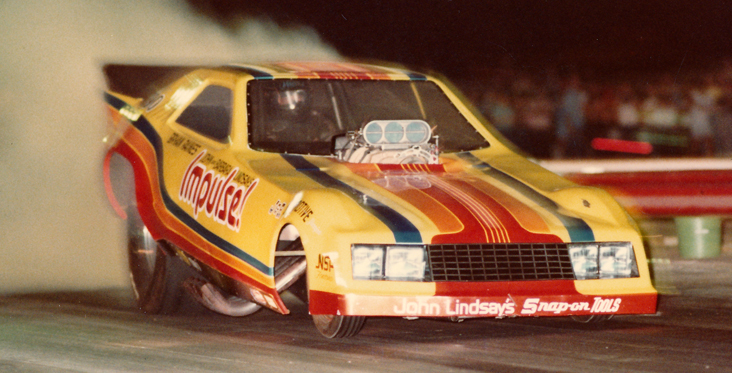
And speaking of good ol’ OCIR, here’s another local favorite who was at the event, John and Barbara Lindsay’s Impulse! Mustang Funny Car (yes, the exclamation point was part of the name; shades of Gary Hazen’s Panic!) with Bryan Raines at the wheel. The multi-hued car was a regular at the ‘County and always put on a good show. Lindsay reportedly licensed in the car in its mid-1970s infancy but didn't care for driving; some of Lindsay’s cars were later driven by Marc Sievers, Ed Moore, Glenn Mikres, Cory Lee, and others.

Johnny West was another OCIR regular (and part of that 64 Funny Cars show), along with his brother Jim. Johnny, who’s still turning wrenches on nitro cars today, drove the Plan A (a name that dated back to his 1970s Fuel Altereds; not sure what Plan B was) while his brother’s car was named Wild Wild West (which I thought was a really cool name). Johnny eventually switched to having just his name on the flanks (as seen here) in 1984 and was tabbed to drive Roland Leong’s Hawaiian Punch Dodge and the end of the following season, replacing Rick Johnson. West and Leong were the runner-ups to Prudhomme at “the Snake’s” 1987 Gatornationals return to the winner’s circle and also were runner-up to Bernstein at that year’s Cajun Nationals. West had a third shot at a Wally at the Summernationals in 1990 in his own Banzai Beretta, but the car got loose racing Chuck Etchells in the final and smacked the guardwall just off the starting line. West was knocked out and the car went off the end of the track, though he suffered only minor injuries.
OK, race fans, that’s your look back at some 1980s Funny Cars and the final installment from the Lewis collection. Thanks again to Ron for sharing his library and allowing me to cherry pick through them for my own entertainment and your education.
![]()

It was a sad day earlier this week when I learned of the passing last Sunday of Texas nitro tuning veteran Bobby Rex, who’s been a part of drag racing for as long as I’ve been a fan. Rex, who first came to notoriety as the tuner of Johnny Valdez’s Mexican Revolution Funny Car in the 1970s (photo by Steve Reyes below), earned a second round of tuning notoriety in Top Fuel with Doug Foxworth throughout the ‘90s. The team had some good times and some rough times –- including a blowover and a crash -– but Rex finally reached the winner’s circle of an IHRA event with Jim Bailey driving his car, dubbed Havoc.
Bobby was one of the truly great guys, always happy to see you and ready to talk cars. I’d see him every year at Texas Motorplex during the national event there, usually running into him in the pits as he cruised around talking to his old pals. He seemed like he was always smiling and always genuinely happy to see me, even all these years later. He lost his battle with cancer and even though he’s gone, I’ll still fondly think of him with every trip to the Motorplex. RIP Bobby. You'll be missed.

![]()
With Christmas looming and NHRA’s annual holiday shutdown around the corner to this will be the final Dragster Insider of 2018. I truly appreciate all of the feedback I receive and try to answer as many emails as I can, but sometimes the volume is overwhelming. If I missed you, please know that your message was appreciated. I’ve been doing this column for more than 11 years now, and still thrill at the shared passion we all have for looking back at our sport’s history and the people who helped make it.
I’ll be back in early January, but until then, feel free to pore through the Insider archives, linked below. It’s searchable on PCs and mobile devices, and I’m pretty confident that if you search for the name of your favorite driver you’re going to find some good reading about him or her. There are more than 700 columns in there (lost count), and plenty of topics and threads to keep you stocked up. Happy holidays to everyone, and thank you again for the support, contributions, and love.
Phil Burgess can reached at pburgess@nhra.com



















































